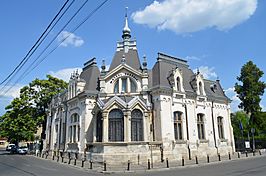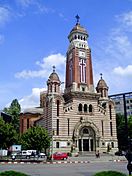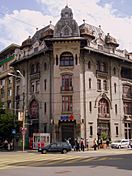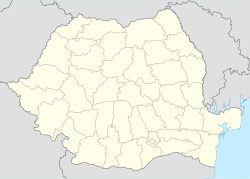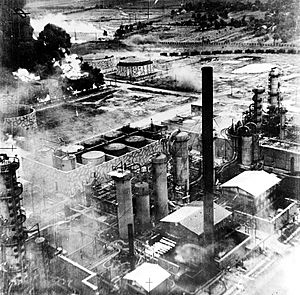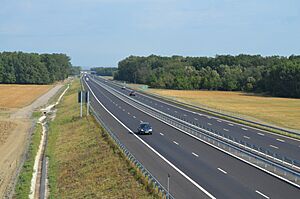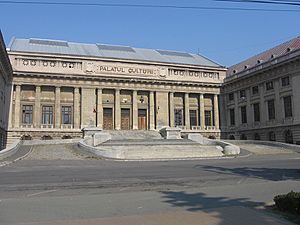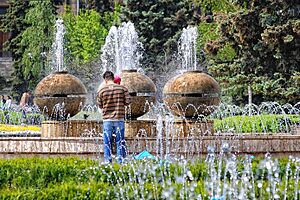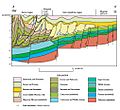Ploiești facts for kids
Quick facts for kids
Ploiești
|
||
|---|---|---|
|
Left to right: Nicolae Simache Clock Museum, St. John the Baptist Cathedral, the former Creditul Prahovei, the Ghiță Stoenescu House, the Radu Stanian House.
|
||
|
||
| Nickname(s):
Capitala Aurului Negru
(English: the Capital of Black Gold) |
||
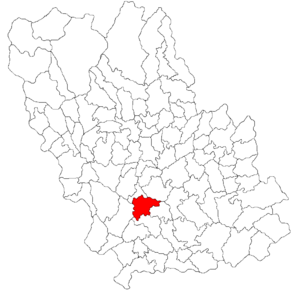
Location in Prahova County
|
||
| Country | ||
| County | Prahova | |
| Status | County seat | |
| Area | ||
| • City | 48.28 km2 (18.64 sq mi) | |
| Elevation | 160 m (520 ft) | |
| Population
(2021 census)
|
||
| • City | 180,540 | |
| • Rank | 10th | |
| • Density | 3,098/km2 (8,020/sq mi) | |
| • Metro | 266,4571 | |
| Time zone | UTC+2 (EET) | |
| • Summer (DST) | UTC+3 (EEST) | |
| Postal code |
100xxx
|
|
| Area code(s) | (+40) 44 | |
| Car plate | PH | |
| 1 Ploiești metropolitan area is a proposed project. | ||
Ploiești is a large city in Prahova County, Romania. It's the main city of the county. Ploiești is part of the historical region called Muntenia. It is located about 56 kilometers (35 miles) north of Bucharest, the capital city of Romania.
The city covers an area of about 60 square kilometers (23 square miles). It is surrounded by several smaller towns and villages. According to the 2021 census, Ploiești is the tenth most populated city in Romania. It has a population of 180,540 people.
Ploiești started growing in the 1600s. It became an important city for trade. Its growth really sped up when the world's first industrial-scale oil refinery opened there in 1856–1857. Because of the huge amount of oil found and processed in the area, Ploiești became known as "the Capital of Black Gold." Even today, its economy is still mostly about processing oil. The city has three big oil refineries and other related industries.
Ploiești is also a very important transport hub. It connects Romania's capital city, Bucharest, with the regions of Transylvania and Moldavia. The city also provides easy access to the Prahova Valley. This valley is one of the most important mountain tourism areas in Romania.
Contents
Ploiești's History: A Quick Look
Ploiești was likely settled much earlier, but it first appeared in official papers in the 1500s. This was during the time of Michael the Brave, who was the Prince of Wallachia from 1593 to 1601. The city became a busy center for trade and making things by hand in the 1600s and 1700s. A road connecting Ploiești to Brașov opened in 1864, and the railway arrived in 1882. Many schools and hospitals were built during this time.
Oil and Early Challenges
In the mid-1800s, the Ploiești area became one of the world's top places for getting and refining oil. The Mehedințeanu brothers opened the world's first large oil refinery in Ploiești between 1856 and 1857. The city is also known for the short-lived "Republic of Ploiești." This was a revolt in 1870 against the Romanian monarchy.
Ploiești During World Wars
During World War I, Ploiești's oil production made it a target. When the Central Powers invaded Romania in 1916, a British operation destroyed much of the oil production and equipment.
Ploiești was badly damaged by an earthquake in November 1940. However, it still provided a lot of oil for Nazi Germany during much of World War II. The Allied forces bombed Ploiești many times. This included Operation Tidal Wave on August 1, 1943. These attacks caused a lot of damage and loss, but they didn't stop the oil production for long. Soviet Red Army troops captured Ploiești on August 24, 1944.
After the war, the new Communist government in Romania took control of the oil industry. It had mostly been owned by private companies. The government invested a lot of money to modernize the oil industry and fix the damage from the war.
Who Lives in Ploiești?
| Historical population | ||
|---|---|---|
| Year | Pop. | ±% |
| 1810 | 2,024 | — |
| 1859 | 26,468 | +1207.7% |
| 1899 | 45,107 | +70.4% |
| 1912 | 56,460 | +25.2% |
| 1930 | 79,149 | +40.2% |
| 1941 | 107,068 | +35.3% |
| 1948 | 95,632 | −10.7% |
| 1956 | 114,544 | +19.8% |
| 1966 | 146,922 | +28.3% |
| 1977 | 199,699 | +35.9% |
| 1992 | 252,715 | +26.5% |
| 2002 | 232,527 | −8.0% |
| 2011 | 209,945 | −9.7% |
| 2021 | 180,540 | −14.0% |
| Source: Census data, 1930–1948. | ||
The number of people living in Ploiești grew very quickly. This was because of the strong economic growth in the area. In 1810, there were only about 2,024 people. By 1859, the population was 26,458. In January 1992, it reached 252,715.
However, since the fall of Communism in Romania, the city's population has slowly decreased. This is due to people moving away and fewer births. In 2021, the population was 180,540.
Ethnic and Religious Groups
Most people in Ploiești are ethnic Romanians (90.64%). There is also a Roma minority (2.4%) living in some parts of the city. For 6.65% of the population, their ethnic group is not known. Most people in Ploiești are Orthodox Christians (90.7%).
| Census | Ethnic composition | ||||||||||
|---|---|---|---|---|---|---|---|---|---|---|---|
| Year | Population | Romanians | Hungarians | Germans | Serbs | Jews | Romani | Russians | Greeks | Ukrainians | |
| 1930 | 79,149 | 69,139 | 1,591 | 1,307 | |||||||
| 2011 | 201,226 | 199,221 | 109 | 69 | – | – | 1289 | 44 | – | 8 | |
How Ploiești Makes Money
After the Romanian Revolution in 1989, Ploiești faced some economic challenges. However, it is now a strong industrial center. It focuses especially on oil production and refining. Even though oil production in the area is slowly going down, there is still a busy oil processing industry. The city has four working oil refineries. These are connected by pipelines to Bucharest, the Black Sea port of Constanța, and the Danube port of Giurgiu. Ploiești also has a long history of making textiles.
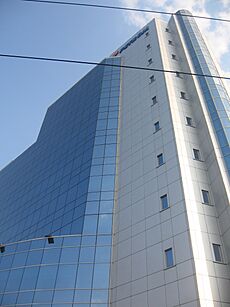
The city has become a popular place for foreign companies to invest. Big companies like OMV-Petrom, Lukoil, Shell Gas, Timken, Yazaki, Coca-Cola, Efes Pilsener, British American Tobacco, Federal-Mogul, and Interbrew have businesses there. Many well-known stores like Carrefour, Metro, Selgros, Kaufland, Billa, Bricostore, Lidl, Obi, Auchan, Profi, and Mega Image have found a growing market in Ploiești. There are also several McDonald's and KFC restaurants.
In 1950, a special company called SC IPIP SA was started in Ploiești. This company helps design and engineer oil refineries and other chemical plants. It has a lot of experience in the oil and chemical industries.
Ploiești also has four local TV channels: Ploiești TV, Valea Prahovei TV, Wyll TV, and Prahova TV.
Getting Around Ploiești

Ploiești is located on the A3 motorway. This is the main road to Romania's northern and western parts, and to Western Europe. Henri Coandă International Airport is 45 kilometers (28 miles) away. The ski resorts in the Prahova Valley can be reached in about an hour by car. Ploiești is the second most important railway center in Romania, after Bucharest. It connects Bucharest with Transylvania and Moldavia.
The city's public transportation system is run by TCE Ploiești. It has a large network of buses, trolleybuses, and trams. Ploiești's yellow bus fleet is very modern. It connects all parts of the city and serves about 150,000 passengers every day. The city has over 800 streets, totaling 324 kilometers (201 miles) in length. About 241 kilometers (150 miles) of these roads are modern.
Fun and Culture in Ploiești
Ploiești is home to the Ploiești Philharmonic Orchestra. This is one of the best orchestras in Romania. The city also has a famous football club, FC Petrolul Ploiești. There's a women's handball club called CSM Ploiești and a basketball team called CSU Asesoft.
There are many interesting cultural and architectural places to see. These include:
- The Cultural Palace.
- The Clock Museum, which has a collection of clocks and watches gathered by Nicolae Simache.
- The Oil Museum.
- The Ploiești Art Museum, which was given to the city by the Quintus family.
- The Hagi Prodan Museum, built in 1785. This building shows old Romanian architecture.
In August 2011, Ploiești hosted the Golden Carpathian European Film & Fair. A famous musician, Goran Bregovic, also held a concert there.
Many well-known writers have connections to Ploiești. These include Ion Luca Caragiale, Nichita Stănescu, and Geo Bogza. The composer Paul Constantinescu and philosopher Petre P. Negulescu also came from here. Three people who graduated from the "Sfinții Petru și Pavel" High school later became presidents of the Romanian Academy.
Learning in Ploiești
The first school in Ploiești opened in 1777. By 1832, several other elementary schools were open. High school education became available in 1864.
Ploiești has several universities and colleges:
- Oil & Gas University, started in 1948.
- George Barițiu University, started in 2002.
Some important high schools in Ploiești are:
- Mihai Viteazul National College
- Ion Luca Caragiale National College
- Jean Monnet National College
- Alexandru Ioan Cuza National College
- Nichita Stănescu National College
Ploiești's Natural Surroundings
Ploiești is located in the middle of Muntenia, in the central-northern part of the Wallachian Plain. It is close to Bucharest, the capital city. The city is at 25°E longitude and 44°55’N latitude. Ploiești covers about 60 square kilometers (23 square miles).
Two rivers are near the city. The Prahova River briefly passes through the city's southern part. The Teleajen River passes through nearby villages. The city itself is on the Dâmbu River. This river doesn't have a very strong flow today.
Climate of Ploiești
The climate in Ploiești is similar to Bucharest's. It has a temperate humid continental climate with hot summers. The average temperature each year is 10.5°C (50.9°F). The coldest temperature ever recorded was -30°C (-22°F) in January 1952. The hottest was 43°C (109°F) in July 2007.
On average, Ploiești has about 104 days with rain and 26 days with snow each year. The winds mostly come from the north-east and south-east.
| Climate data for Ploiești | |||||||||||||
|---|---|---|---|---|---|---|---|---|---|---|---|---|---|
| Month | Jan | Feb | Mar | Apr | May | Jun | Jul | Aug | Sep | Oct | Nov | Dec | Year |
| Mean daily maximum °C (°F) | 1 (34) |
4 (39) |
10 (50) |
18 (64) |
23 (73) |
27 (81) |
28 (82) |
28 (82) |
24 (75) |
18 (64) |
10 (50) |
3 (37) |
16.2 (61.2) |
| Mean daily minimum °C (°F) | −6 (21) |
−3 (27) |
0 (32) |
6 (43) |
10 (50) |
14 (57) |
16 (61) |
15 (59) |
11 (52) |
6 (43) |
1 (34) |
−3 (27) |
5.6 (42.1) |
| Average precipitation mm (inches) | 40.6 (1.60) |
35.6 (1.40) |
38.1 (1.50) |
45.7 (1.80) |
71.1 (2.80) |
76.2 (3.00) |
63.5 (2.50) |
58.4 (2.30) |
43.2 (1.70) |
33 (1.3) |
48.3 (1.90) |
43.2 (1.70) |
596.9 (23.50) |
| Source: Weather Channel | |||||||||||||
Plants and Green Spaces
Ploiești used to have many forests with pedunculate oak trees. Some parts of these old forests still exist today. Some old oak trees are now protected by law.
Today, the plants in Ploiești are mostly those found in cities. These include ornamental plants and trees like chestnut, aspen, and black locust. There are not many parks or green areas. The main green spaces include the central boulevard, a park near Sala Sporturilor, and the "Mihai Viteazul" park. These areas cover about 85.5 hectares (211 acres).
Around the city, you can also find some rare trees that are protected. One example is the giant redwood (Sequoiadendron giganteum) in the garden of the "Paul Constantinescu" museum. Some fruit trees, like figs, have also adapted to the local climate. More fruit trees and flowers are being planted in some neighborhoods.
Sister Cities
Ploiești is twinned with several cities around the world. This means they have a special friendship and cultural exchange.
Famous People from Ploiești
Many notable people were born or lived in Ploiești:
- Academics: Liviu Librescu, Nicolae Simache
- Arts and Film: Geta Brătescu, Fory Etterle, Christian Magdu
- Literature: Paul Constantinescu, Lazăr Șăineanu, Nichita Stănescu
- Music: Andreea Bălan, Sonny Flame, Nico, George Nicolescu
- Politics: Roberta Anastase, Take Ionescu, Corneliu Mănescu
- Science: Mihai Ioan Botez, Basarab Nicolescu
- Sports: Octavian Belu, Tamara Costache, Leonard Doroftei, Adrian Diaconu
Images for kids
-
Teleajen River in Prahova County
See also
 In Spanish: Ploiești para niños
In Spanish: Ploiești para niños


